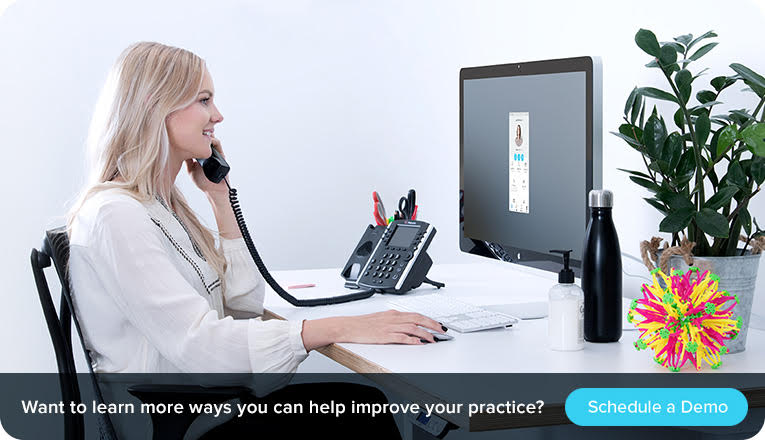
20 Office Management Tips For An Efficient Business
Efficiency: the ability to accomplish a job with a minimum expenditure of time and effort. Isn’t this what we all hope to do with our businesses? What would you do with some extra time if you maximized your efficiency? Here are some ways to help make your office hum and free you up to focus on creating an office that exceeds expectations.
As we go through each of these, you may find yourself looking for solutions that help business owners manage their businesses more efficiently. If you find yourself in that boat, check out all of the awesome solutions that Weave offers for small businesses!
Customer Communication

-
-
Modern Communication Methods
Today, it is all about making everything as convenient as possible for your customers, especially in regards to communication. If you can’t keep up with the fast-paced, hustle and bustle of your customers’ lives, your calls may be ignored. However, by communicating with customers the same way they communicate with their friends and family, you are going to see a huge difference for your business. What this means for you is “out with the old and in with the new”, or in other words, out with mailers or appointment reminder phone calls and in with texting!
People can now read their texts from their watches, phones, computers AND tablets, it is easy to respond and it does not require them to step out of meetings, recitals or their child’s soccer game in order to confirm. It is convenient! You’ll see a higher success rate, and they will appreciate that you considered their busy lives when texting them to confirm their upcoming appointment. Weave offers an efficient appointment reminder software. Check out the features here.
-
Automated billing
Speaking of convenient, we’re pretty sure that “automated billing” is a synonym. By modernizing your billing methods, you are saving yourself and your customers a lot of valuable time.
-
The “now” customer attitude
From online purchases, next day delivery, and options to “skip the line”, we live in a pretty instantaneous world, and it is no different for your customers. They have the same “now” attitude and may go elsewhere if they can’t be accommodated.
Nathan Paris, in his article, “3 Best Practice Management Tips for the New Dental Patient” said, “If you can schedule a new patient within 72 hours, he or she is less likely to hang up and call another practice. Also, the new patient will often tell his or her friends how easy it was to schedule an appointment in your office.” So how do you guarantee an appointment for these “now” customers? The solution is simple–always block out time for new customers. You will want to base how much time you block out each day on your new client acquisition goals, but a good system may be to keep 1 or 2 appointment slots empty for at least 48 hours before the appointment time, then open it up to all customers.
-
Upset Customers
Bad things happen, and unfortunately sometimes they happen to your customers. You do your best to minimize situations that are within your realm of control, but a lot of times a customer becomes upset about something beyond your control. Don’t look at upset customers as a hindrance to your business, but rather an opportunity.
If one of your customers is upset about something it gives you the opportunity to show how much you care and are willing to help. If your office or staff caused the initial problem then you can go above and beyond in trying to remedy the situation. If the problem happened outside of your office the customer will appreciate anything you are doing to try and help. Teach your team to look at any adversity as a seed of opportunity.
-
Body Language
Did you know that body language can influence a customer’s perspective of your entire business? Unfortunately, this change in perspective can take place as early as the first few minutes of interacting with the front office team. The good news is that a simple smile, friendly tone of voice, making eye contact, and positioning your body in a way that is open and friendly can make a huge difference in the customer experience. Take a look at your own body language while at work and continuously evaluate the way you and your team are being received.
-
Statement of Work (SOW)
Handing your customers a personalized “walk out” statement of work will not only effectively communicate what went on while they were in the office, but it is a great customer service strategy. It is important to include things the business did that customers rarely know about, for example, any screenings, preventative measures, etc. so customers are always aware of the level of service your business provides.
-
Continued Care
It is important that your customer communication does not start and end in the office. In order for your business to have and maintain sincere relationships with customers, you need to have a continued care strategy. These strategies may include scheduled touchpoints with customers between appointments, adding personal touches to reach outs, etc. See the below “Automate your continued care” section for more tips on how to facilitate customer retention through continuous care.
-
Automate your continuous care

-
-
New client welcome
Sending your new customers a welcome email, note or card that includes personal and specific information about them and/or their family, helps to create loyal customers for your business. Be sure to include a link to your website and any other information they may need.
-
Birthday reach outs
Another great way to make your customers feel important is to wish them a happy birthday. Reaching out with a quick text or email on their birthday is the perfect way to show your customers they aren’t just a number to your business. We recommend putting together a birthday template that you can easily adjust and send to each client. This will help you save time, yet allow you to still add your personal touch.
-
Value-added touchpoints
Having touchpoints with customers between appointments is huge for your business’ continued care strategy. However, it is important to provide a value-add for your customers so they don’t feel as though they are being spammed by your office. The best way to do this is to keep your emails educational, informative and concise. For example, you could send your customers a quick nutritional counseling email a month or so after their appointment, or an email that reminds them of proper hygiene techniques. Some additional ideas would be a fun email that debunks current hygiene trends and give tips of your own instead, or an email with a note from the business owner.
-
Organize

-
-
Spring Cleaning
Schedule a few hours once every 6 months (at least) to declutter your office as a team. Depending on your office, this may require all hands to be on deck, so scheduling this for a day when your office is typically slow, or even after-hours is important. We’ve provided you with some helpful tips to reference during your semi-annual office purges. These tips will keep you from becoming demotivated and help you stay organized long after you’ve decluttered:
-
Tackle categories
Rather than decluttering by specific room/area/space, organize by category. For example, tackle all of your customer files at once, or all of your sticky notes. This will help you maintain momentum and quickly rein in the clutter.
-
Gather and redistribute
This goes hand-in-hand with tackling categories, but puts an emphasis on redistributing the items after you’ve tackled them. Have a plan for organized redistribution with each item you gather and make sure every member of your team knows the plan/where everything belongs.
-
Establish ‘work zones’
As you start gathering and redistributing throughout your office, you may see the need to establish work zones in order to help you start designating space for each item. These work zones may include your main workspace, a reference area, and a supply area. This will help you establish your organization throughout the office.
-
Don’t forget your drawers, cubbies and other storage nooks
It is easy to declutter and clean your desk, but a little more intimidating to face the cubby where you hide away all of the to-dos you haven’t gotten to yet. Don’t put off these intimidating nooks for another day!
-
Start and finish on the same day
This is a simple tip we borrowed from the book, “The Life-Changing Magic of Tidying Up” by Marie Kondo. In her book she has rules for effective decluttering, and the most important one is to start and finish all in the same day. This will keep your momentum up and help you avoid areas of the office from continuing to pile up.
-
Update your filing system
Use this set aside time to tackle projects you otherwise aren’t able to get to, like updating your filing system. This will not only go a long way in keeping your office organized long-term, but will make your day-to-day a little easier.
-
Gather storage boxes beforehand
Rather than letting ‘to be archived’ papers pile up, be prepared with the boxes and other materials you need to not only sort and organize, but to remove from your office.
-
Invest in a good labeler
Never underestimate the power of a good labeler. Everything in your office should have a place, and a labeler will help you establish those designated spots.
-
Sort mail
Use the aforementioned labeler to organize the mail that is scattered over everyone’s desk. For example, creating a ‘to act’, ‘to read’, ‘to file’ and ‘to delegate’ system will help your team know what is a priority and what can wait until later (plus nothing will get lost).
-
Utilize your folders
Folders are not just for customer files. Use them to create a meeting folder, items to be discussed folder, items to be handed off folder, etc. Whatever you need to do to help you remember tasks and stay organized!
-
Create a WOR folder (Waiting on Response)
This will keep your interactions from being forgotten, which can be a game changer for the busy, front office atmosphere.
-
Love your space
At the end of the day, the goal is to be inspired by your work space. You spend a lot of time in your office, so organize it the way that works best for you and your team!
-
-
Effective team

-
Establish the Right Culture
Start off on the right foot by establishing a culture of efficiency. Remember, micromanagement isn’t efficient; empower team members with knowledge and help, be flexible, and give them opportunities to identify and own ways that they can improve. It takes a lot of time and effort to establish great culture, but once it’s in place, it’s much easier to keep the momentum going for each new employee that’s hired.
-
Establish goals and performance expectations
An effective team is a team that knows where they are going and how to get there. Everybody needs to be on the same page, and the best way to do that is to set clear goals and expectations of performance. There need to be individual goals as well as team goals. Goals move us forward in life and facilitate a desire for continual learning and improvement.
Performance expectations are crucial for a team member to thrive. It helps establish guidelines for daily work, and it is a driving factor to go above and beyond. It’s natural for somebody to do less and less over time if an expectation is not set early on. -
Look at your business
Set up routine and consistent times to look at your entire office at a glance. Try to establish the areas of importance your office is focusing on, and create a checklist of items to discuss with your team on a routine basis. Keep everybody on the same page by routinely examining and improving your processes.
It’s easy to get caught up in the day to day and forget to look at the office as a whole. Take a few steps back from time to time and evaluate what’s really going on. -
Team Building
Set up events or activities outside of your office and give your team a chance to interact with each other outside of the office setting. Team building exercises will give you a pretty clear indicator of your team’s strengths and weaknesses. Your team members need to learn to trust each other and team building exercises have shown to do that.
-
Cross-Train
Your front office team doesn’t necessarily need to be able to do the jobs of all of their co-workers, but it can be a great help knowing what other people on the team are doing, what their processes are and why.
Giving people a wider view of where they fit in and why may help the team adjust their own processes to make the overall process more smooth and can help with overall attitude once they understand why it makes sense that so-and-so does it one way and not another. Cross-training can also be good and help team members feel valued when they can explain what they do and why they’re doing it a certain way.
Also, if you’ve got a good culture, other team members may have some helpful and fresh insights on how to improve things in different areas.
-
Interactive Team Notes
Ever jot down some information about a customer on a sticky note and then file it away in your own indecipherable sticky-note organization system? While that may be great for an individual team member, it doesn’t give much help to the rest of the team. When you make your notes digital, interactive and accessible to the team, it cuts down on a lot of miscommunication and re-communication.
There are business management softwares that have this feature built specifically for more medically-oriented notes, but there are also services that offer a place for the team to put more “social-type” notes. Maybe you want to let the team know about a life-changing event in someone’s life, or that a particular customer really likes to chat a lot on the phone, or whatever someone feels like it would be good for the team to know about any given customer.
-
Training and continuing education
Business Owners must keep learning about new tools and techniques to do great work and stay relevant, and the front office team is no different. Some businesses have created a library of videos and webinars that cover topics ranging from “How to Handle Customer Phone Calls,” “The Importance of Great Customer Service,” to “How to Handle Cancellations and Customer Complaints.” Front Office Rocks has some excellent examples of videos that create a phenomenal resource for any office to train and improve their employees’ knowledge and skills.
-
Continued Improvement
It is safe to say that there is always room for improvement. Even the best, most organized offices should look for ways to enhance their customer care. The good news is that you don’t have to go far from your daily routine to find some creative ways to get better. For example, did you like the way your favorite restaurant resolved an issue with your bill? Have you noticed that the pediatrician you take your kids to, or the family doctor down the street from your house has efficient care and management strategies? Being in the habit of constantly looking for ideas and inspiration from your daily surroundings in order to improve your own office care will go a long way for your customers.
-
Morning Huddles
One of the best things you can do to start the week or day off right is to have a morning huddle. As someone with an exceptionally efficient business once said: “A day without a huddle is a waste of the day.” Morning huddles can be an effective way to communicate amongst team members, get a snapshot of the day before it begins, recognize the accomplishments of someone in the office, share roadblocks or give specific client updates. Here are a few things that are necessary for any huddle to go right:
-
Prepare
If you’re running the meeting, make sure that you’re prepared. Make sure you have the day’s schedule and all necessary information on hand before you start, and be sure to prioritize what’s going to be covered. Nothing can start the whispers of, “Why is this necessary?” faster than meandering through a meeting with no purpose or organization.
-
Start on time
This meeting sets the tone for the rest of the day, and tardiness simply isn’t a good tone to set.
-
Involve everyone
Make sure everyone knows what they’re doing and encourage any questions or comments they may have. You may need to answer these after the meeting or as the day goes on, but make sure you’re listening.
-
Make it fun
The best huddles involve standing up. Everyone should have a chance to participate and hopefully it can be fun to figure out who should speak first. Pass a ball, go clockwise one day, counter-clockwise the next, allowing each team member to do a quick check in and report on their top priorities for the day or week.
-
End on time
Starting on time is key, ending on time is essential. Don’t start off the day behind.
-
Customize to your needs
Maybe your office just needs a huddle once a week. Maybe it’s five minutes, maybe it’s fifteen. Figure out what works for you to make it most effective.
Huddles can be a powerful tool, but they can take a little while to get a team in the habit of running an efficient, useful huddle. Don’t give up if it takes a bit; just remember that taking a few minutes to organize at the beginning of the day can save a lot of business owner and customer time down the line.
-
Hopefully you found a few of these ideas that you’d like to try out. Often the best strategy is to take an idea, test it out for a week and see if it helps. If you enjoy it more than the old way, great! If not, learn from that change and move onto the next idea. Feel free to ask your customers or pay attention to their recent reviews and see if they noticed the business running better. You’d be surprised what they tell you. Best of luck in your efforts!
